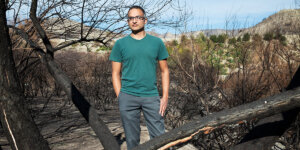
smart city
Compared with cars, trucks, and airplanes, you might not consider a building a major culprit when it comes to energy consumption.
In fact, the operation of buildings amounts to 40% of the national energy demand. With the pressures of climate change, that demand is only going to increase – to make matters worse, the construction industry has been notoriously slow to adopt new technologies.
Under the leadership of department chair Burçin Becerik-Gerber, the USC Sonny Astani Department of Civil & Environmental Engineering (CEE) has become a leading advocate of technologically advanced solutions for the built environment, exemplified by programs such as the MS in Advanced Design & Construction Technology. Intended to train professionals to tackle issues of sustainability through the application of computational tools for data analysis, visualization, modeling and simulation, the course also foregrounds the importance of cross-disciplinary collaboration to bridge the industry’s fragmentation – a mindset that defines the department as a whole.
The CEE approach to education has now been recognized with an important new designation awarded by Dassault Systèmes, the global innovator in 3D, augmented reality and virtual reality software. Through their 3DEXPERIENCE Edu Centers of Excellence program, Dassault Systèmes partners with educational facilities that are playing an outstanding role in accelerating the digital transformation of industry.
CEE is the first center in the program to focus on skills for sustainable innovation in the cities, infrastructure and construction sector. The partnership was spearheaded by David Gerber, professor of practice in civil and environmental engineering and architecture, whose professional experience in architectural, engineering and technology practices has included roles at Zaha Hadid Architects, Gehry Technologies and ARUP.
 “There’s a misconception that civil and environmental engineering is somehow distinct from the tech sector – but actually, contemporary civil and environmental engineering is very computational,” said Gerber. “By promoting innovation in the industry, we’re determined to affect the livability of the planet – acting as environmental stewards by developing energy efficient and economic solutions.”
“There’s a misconception that civil and environmental engineering is somehow distinct from the tech sector – but actually, contemporary civil and environmental engineering is very computational,” said Gerber. “By promoting innovation in the industry, we’re determined to affect the livability of the planet – acting as environmental stewards by developing energy efficient and economic solutions.”
It goes without saying that these skills are also transferable. The type of problem-solving taught at CEE is as relevant to big tech as it is to the design and management of urban infrastructure. The point is that these areas can no longer be siloed, explained Becerik-Gerber, whose vision for smart cities aligns user-centered thinking with data-driven engineering and intelligent systems.
“Civil and environmental engineers will play a crucial role in shaping the future of our planet, leveraging emerging technologies to address pressing environmental challenges and create sustainable solutions,” said Becerik-Gerber. “Through its education of the next generation of change makers, CEE is equipping civil and environmental engineers with the necessary skills to harness technology and lead transformative initiatives for a better, more sustainable future.”
The partnership with Dassault Systèmes marks a new phase in CEE’s advocacy of a technologically progressive educational approach that prioritizes human lived experience and planetary preservation. Building a safer, more sustainable, and prosperous world starts with advanced visualization and building better digital systems.
“3DEXPERIENCE Edu Centers of Excellence combine knowledge and know-how to provide unparalleled learning experiences that foster employability,“ said Florence Verzelen, Executive Vice President, Industry, Marketing & Sustainability at Dassault Systèmes. “The ongoing digital and sustainability transformation requires the elevation of all jobs by providing stakeholders with more opportunities to develop and apply virtual twins created by engineers. The Sonny Astani Department of Civil and Environmental Engineering at USC Viterbi School of Engineering capitalizes on a well-established 3DEXPERIENCE expertise and a transformational vision for the global ecosystem of cities and infrastructure. With our partners in the industry, they advance the workplace for a better future.”
Published on July 27th, 2023
Last updated on November 27th, 2024













